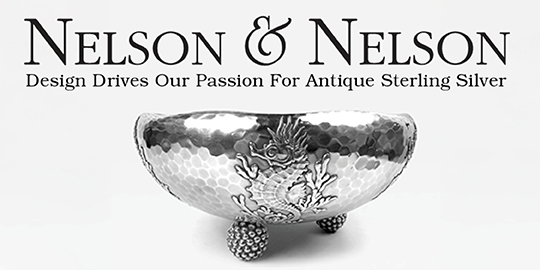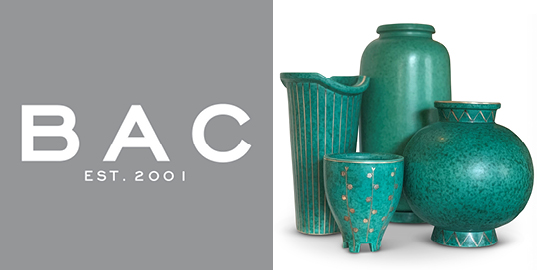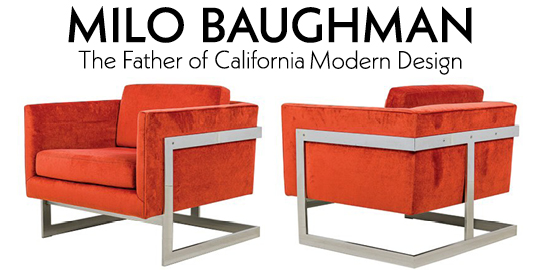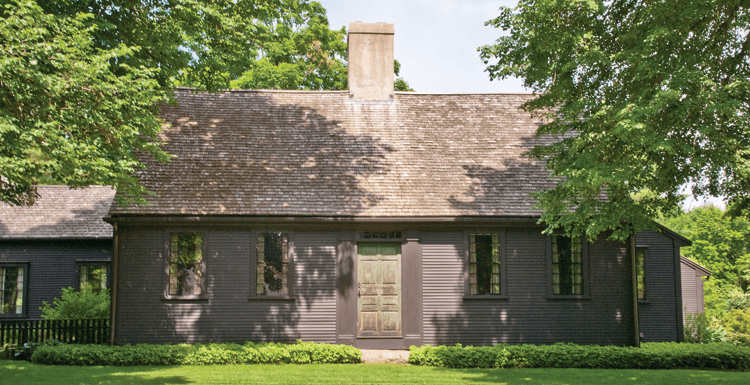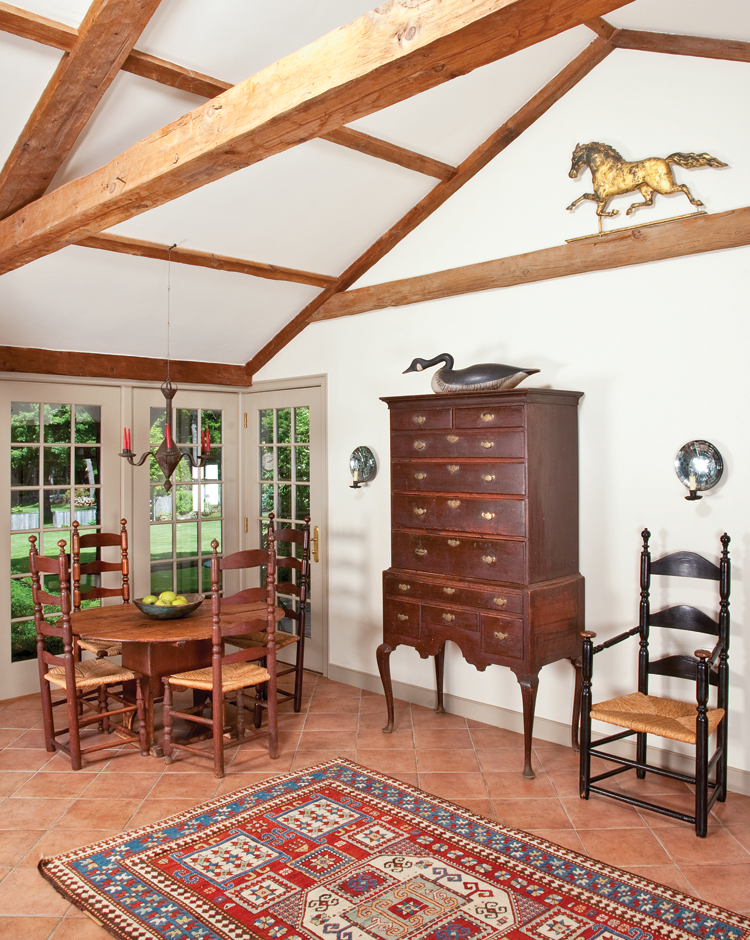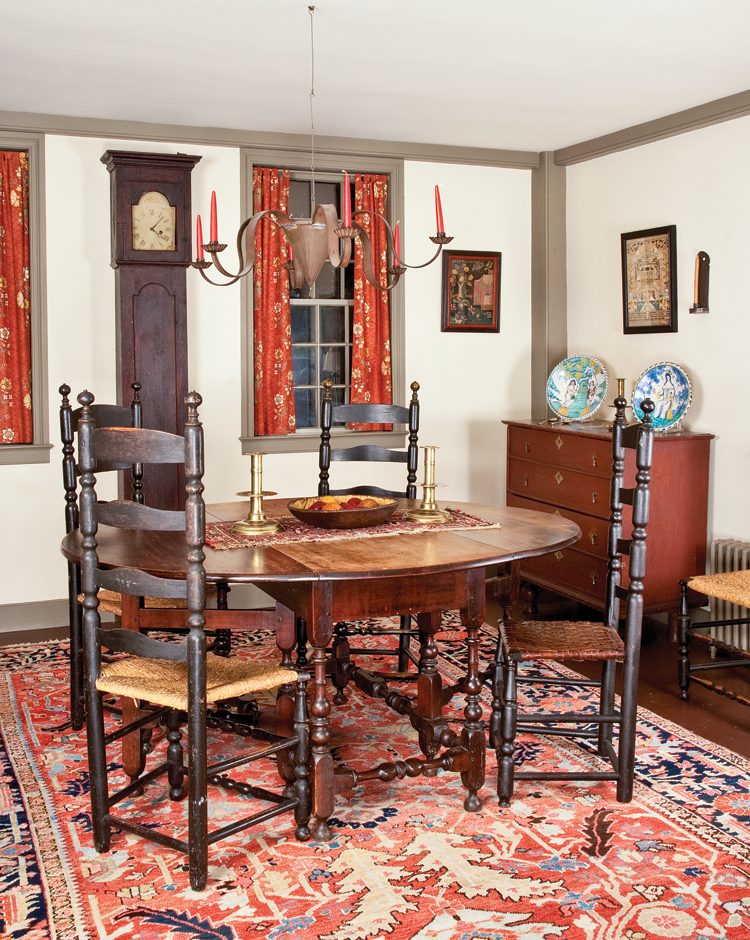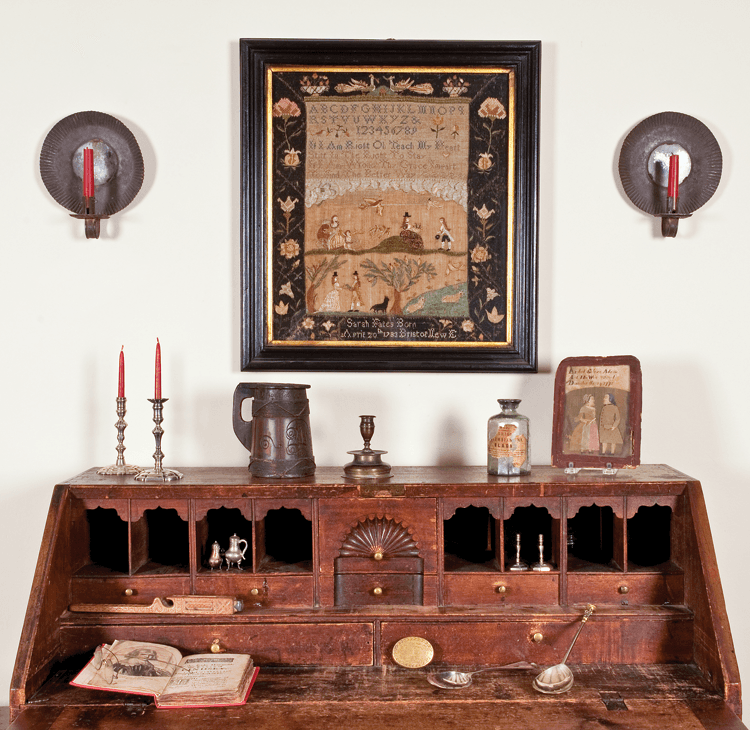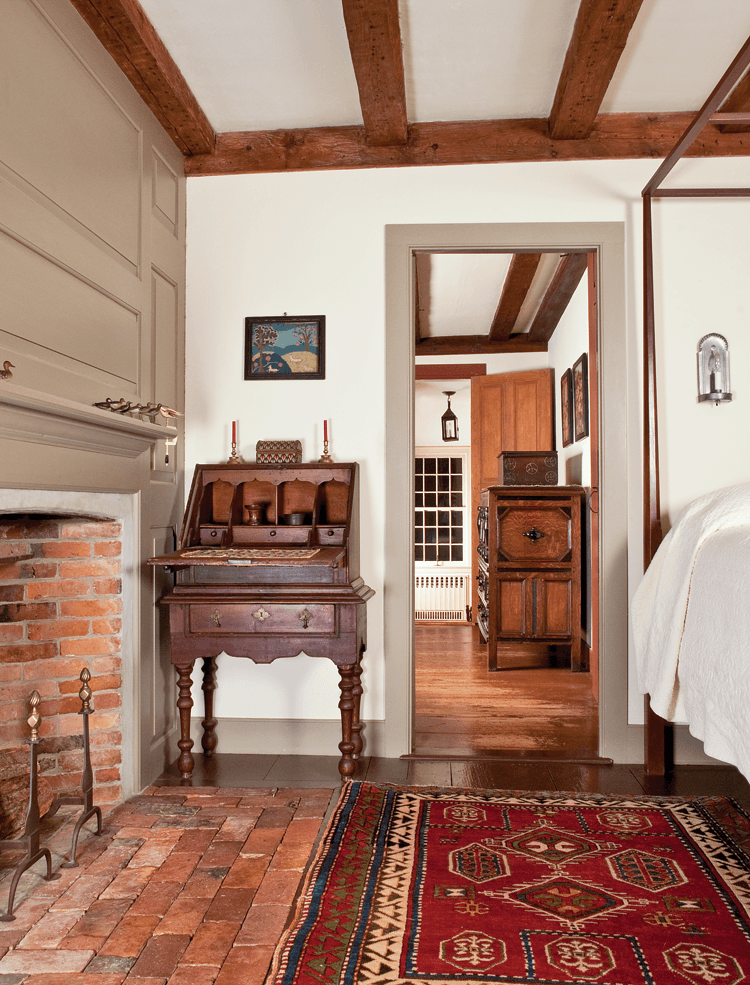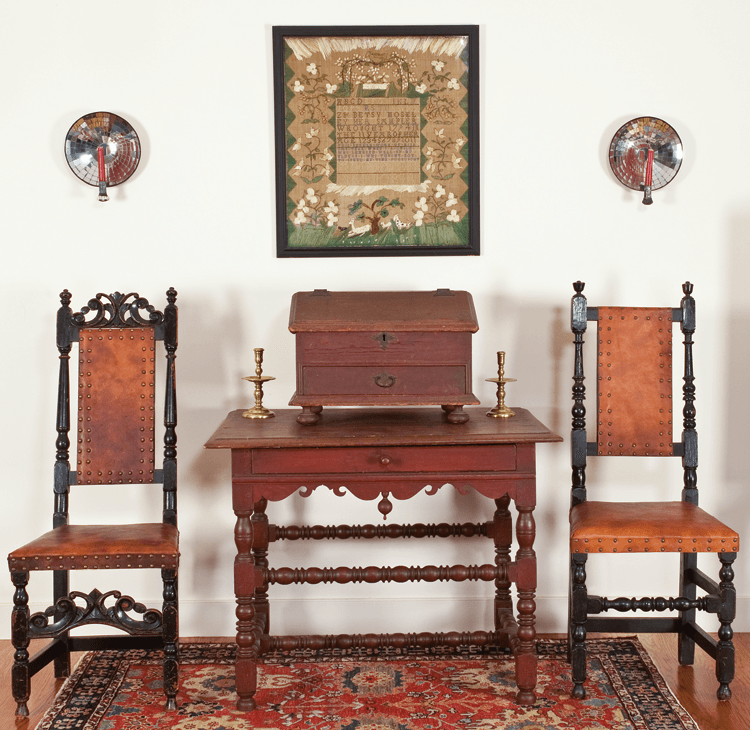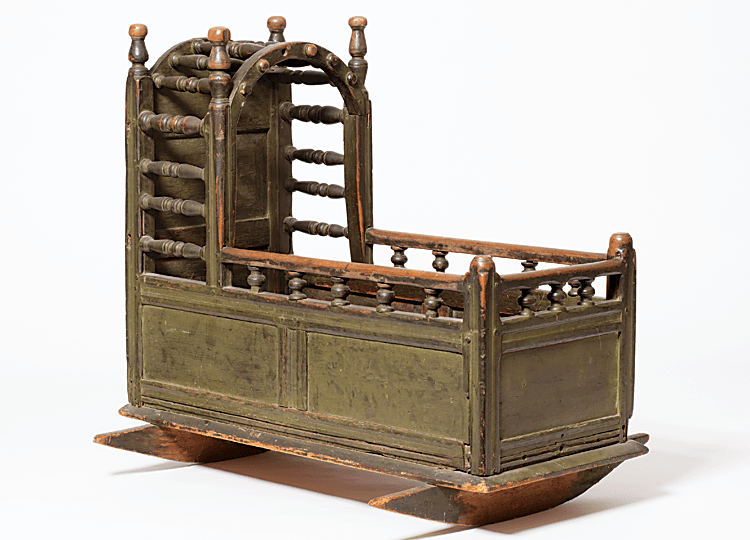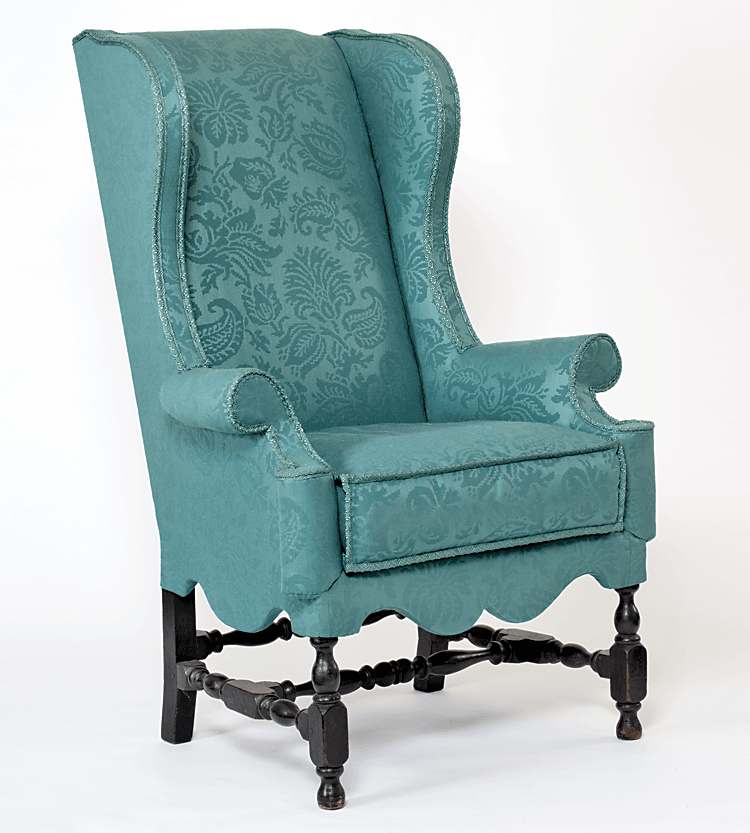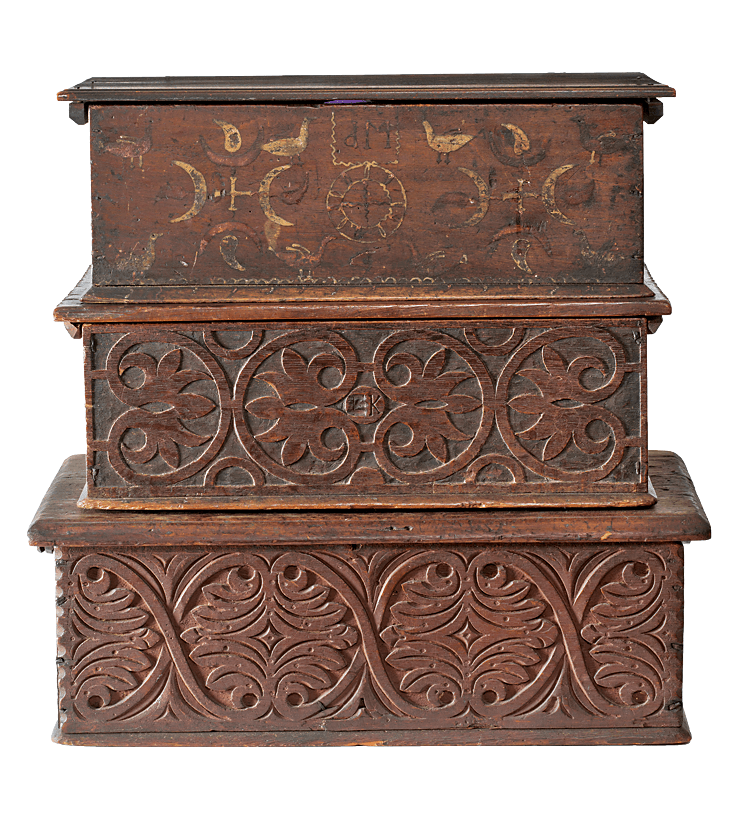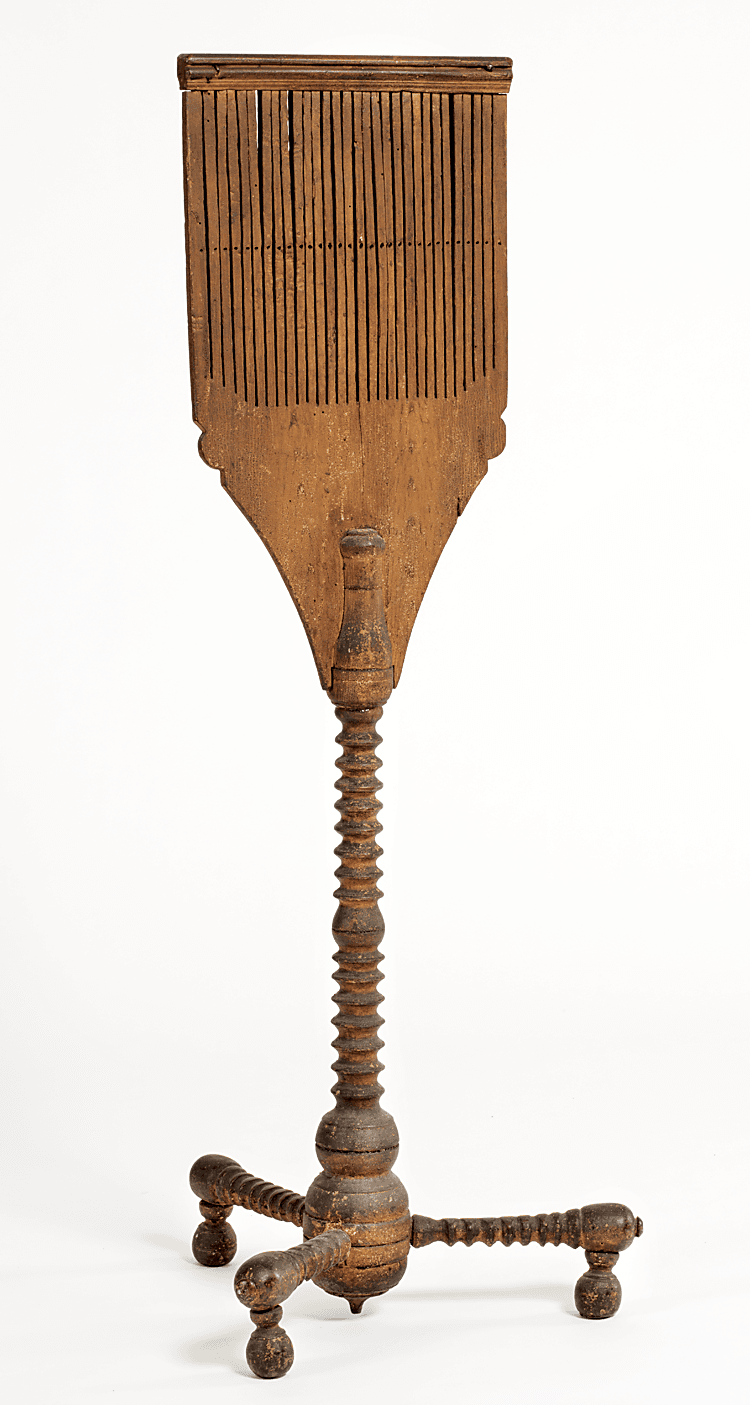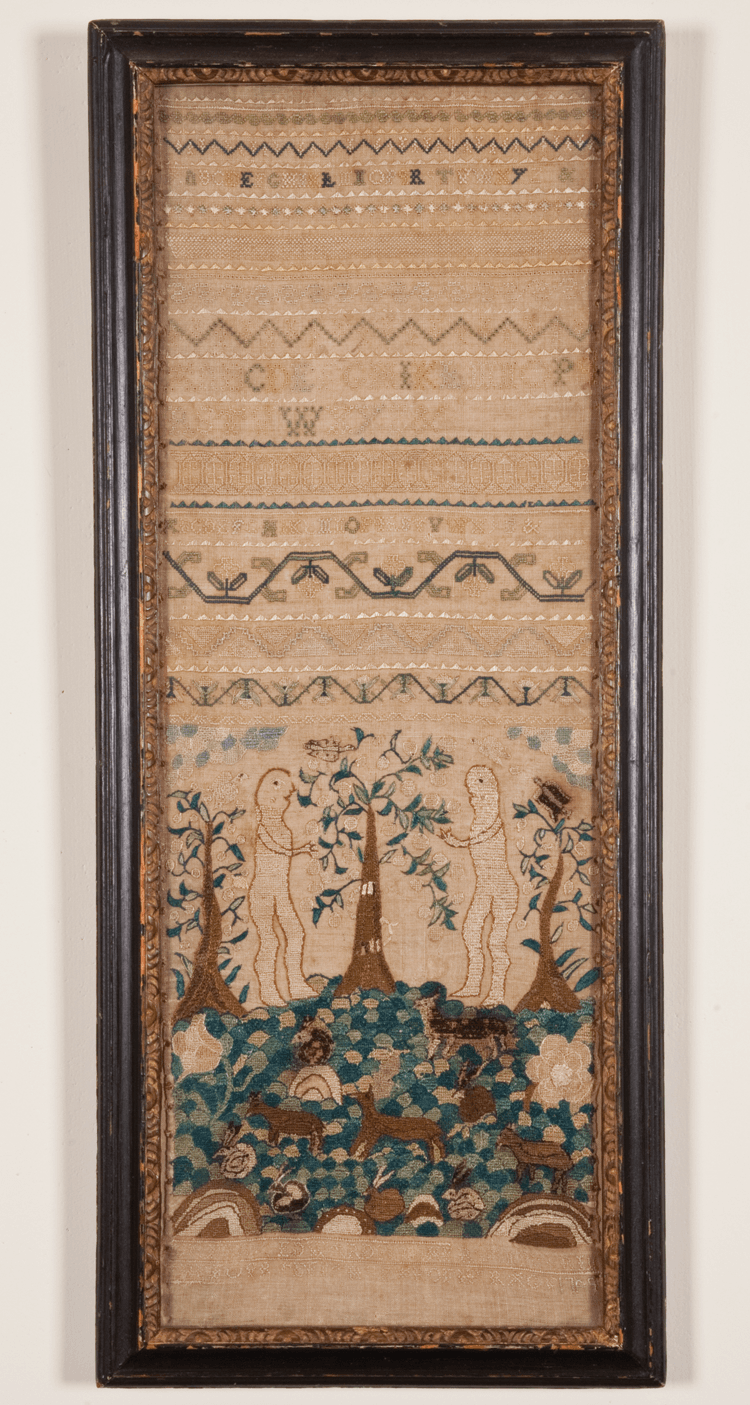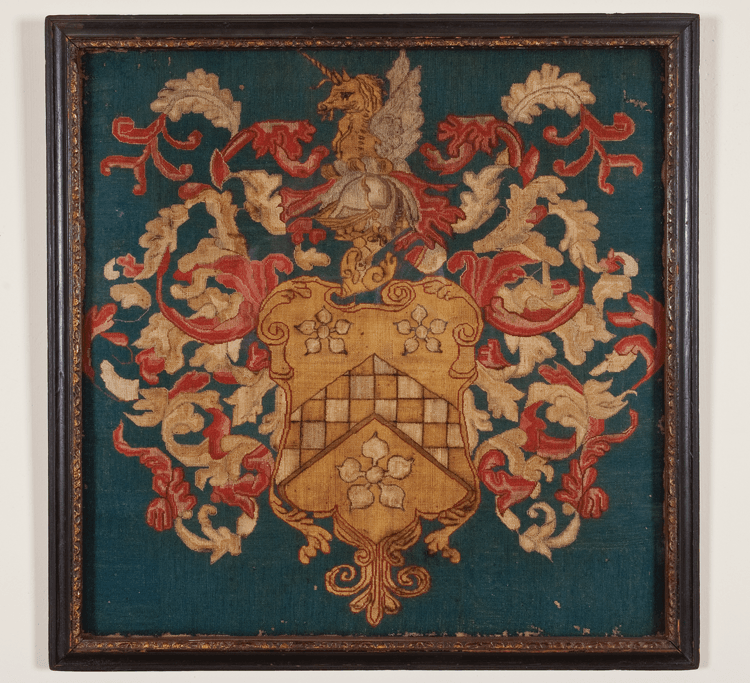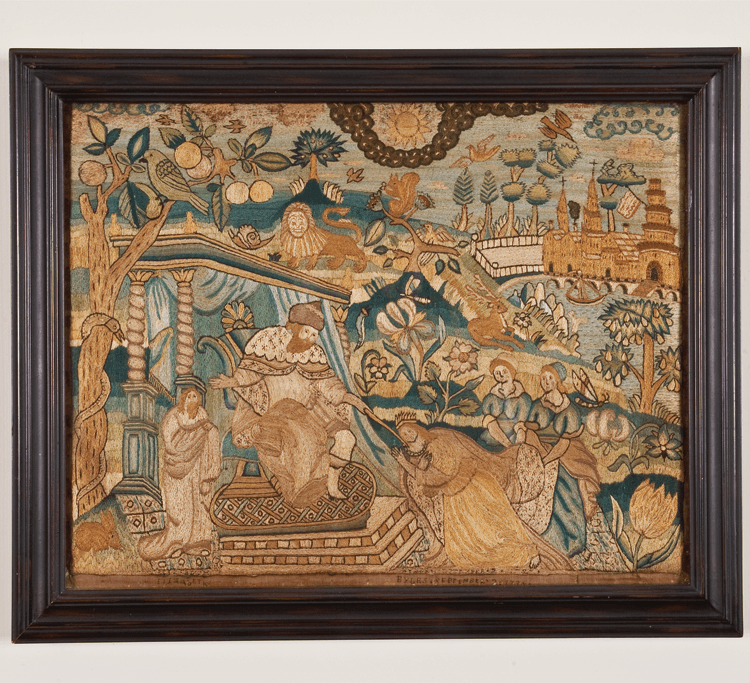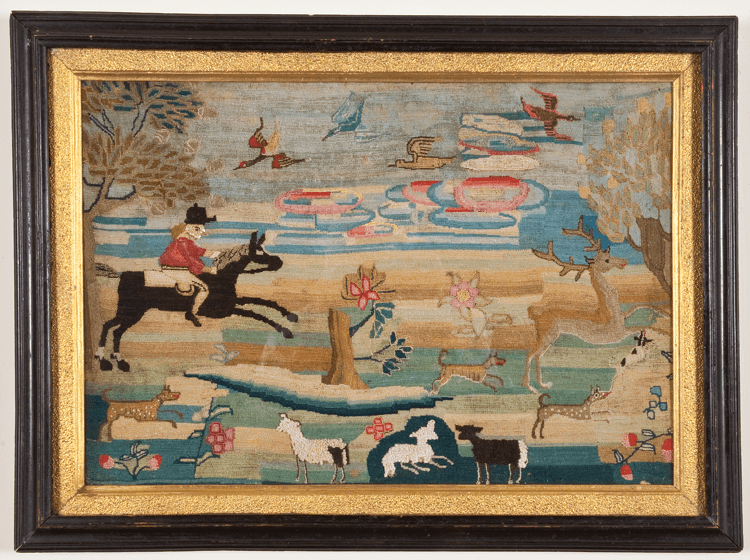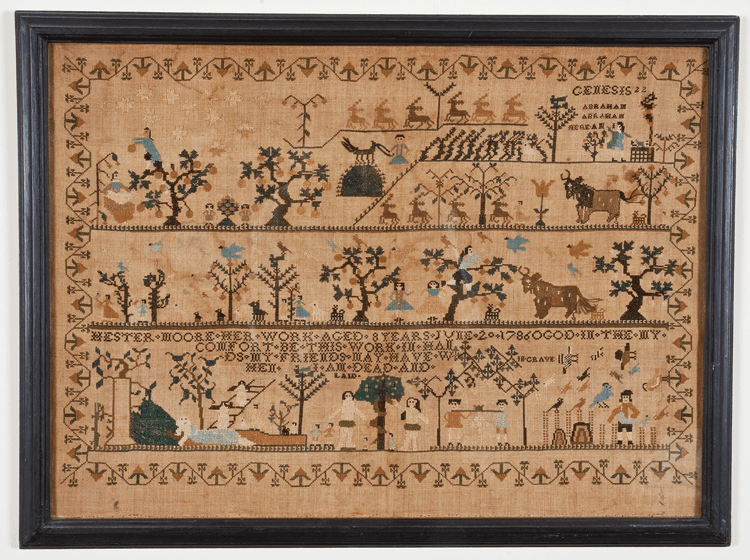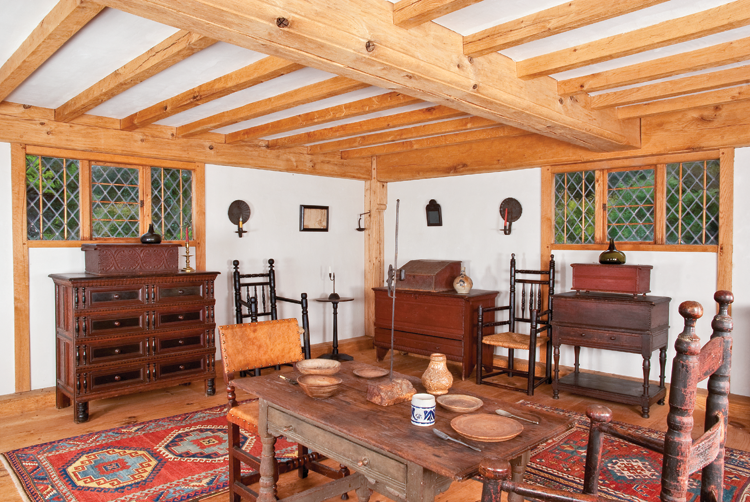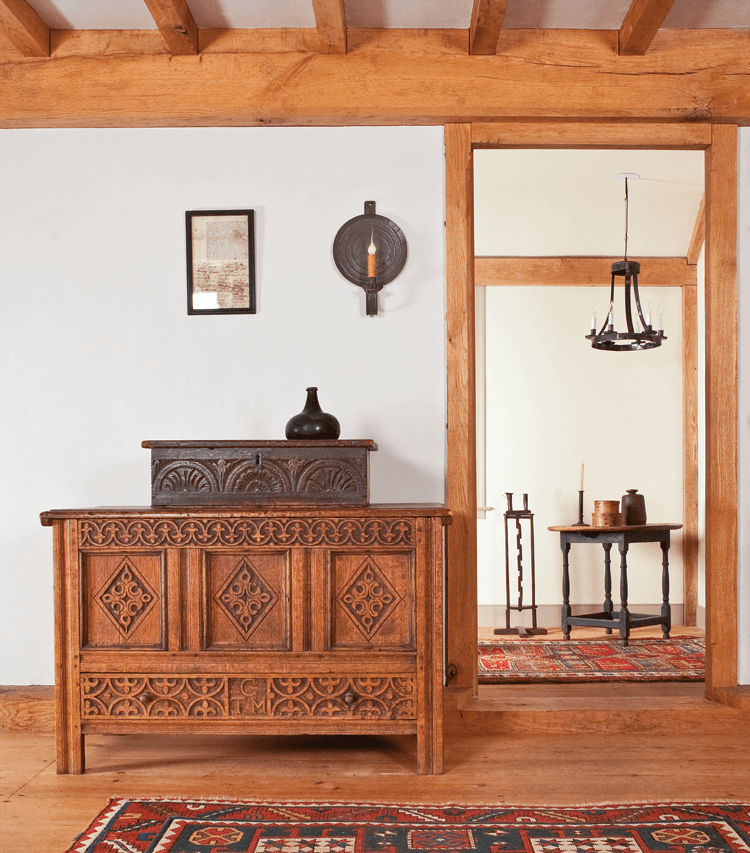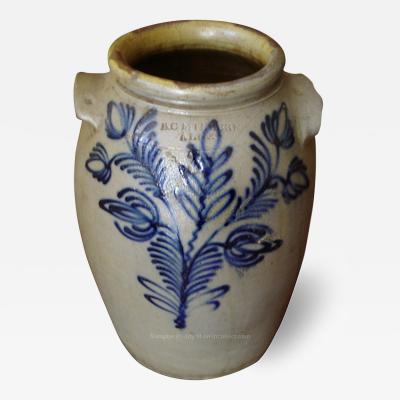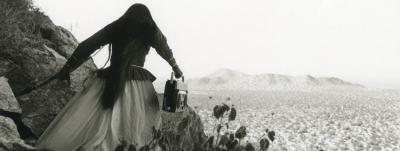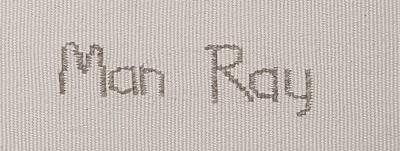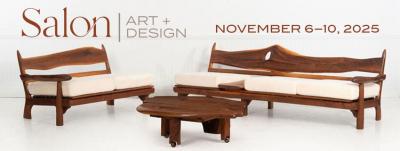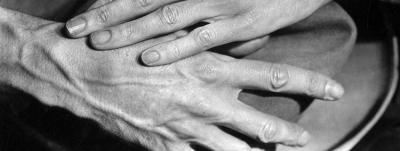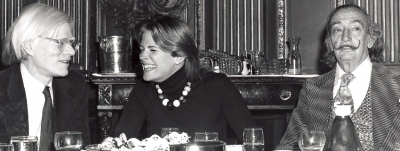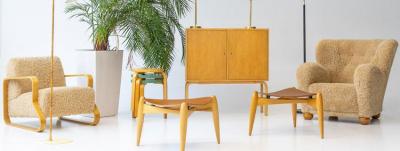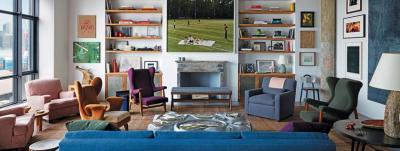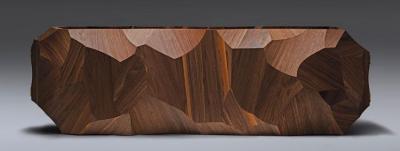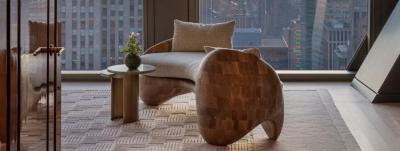Spectacular Vernacular
A passerby might notice this early house and attached barn and comment on how nicely it has been restored and how appropriate the landscaping is to its setting. Small “Capes” like the one in our story are all over New England. But appearances can be deceiving. Hidden from view are well-designed structural additions, visible from the rear, and, at the end of a long sloping lawn, a seventeenth-century style “pool house.” Contained within both buildings is one of the finest collections of pre-Revolutionary vernacular New England material culture in private hands.
I met the home owners in 1974, when they stopped by my shop in New Hampshire. It quickly became apparent that we shared a common interest in the earliest forms of New England furniture and an appreciation for old surfaces. While my interest was, in a sense, learned or acquired, theirs was genetic and probably inescapable—the wife is a direct descendent of John Alden and the husband lists both John Brewster and Stephen Hopkins among his ancestors. Through the years we have built a long-term personal as well as business relationship.
The contents of their eighteenth-century home on the South Shore of Massachusetts, which they have shared for nearly fifty years, is fitting testimony to their consistency, taste, and passion. As the room settings here show, they have assembled very rare furniture, textiles, and pottery in a comfortable living space where they raised four daughters, and where their many grandchildren now gather. The collectors point out that the only object ever damaged was a mirror knocked over by a family cat!
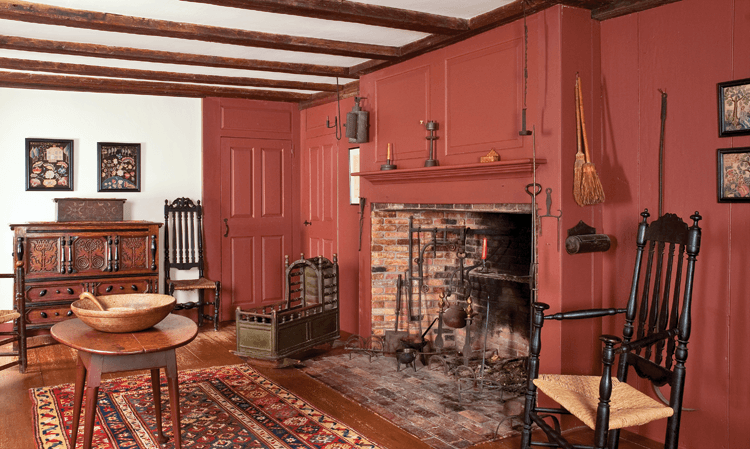
- This view of the keeping room shows the massive baking fireplace filled with andirons and cooking utensils of the eighteenth century, most dating before 1750. The mushroom-armed banister-back armchair is from the Connecticut Shore, ca. 1720–1730. The Hinckley cradle has a place of prominence. The pierced-crested banister-back side chair is one of a close pair made north of Boston, ca. 1720–1735. The tulip and sunflower chest is from the Wethersfield/Hartford, Connecticut, area, ca. 1690–1700, and retains all of its original applied ornament. The box on the chest is one of a small group of similarly painted pieces from Hampton, New Hampton, and dated to the 1720–1730 period. The splay-legged New Hampshire tea table in the foreground retains its original red painted base and has a very fine scrubbed top.
As their family and collection grew, more space was needed and they added the large family room facing the rear gardens and grounds. In the 1990s they added the pool house, a near copy of the 1680 Jethro Coffin house on Nantucket. Made entirely with hand tools and using the framing and finish materials that would have been used in the seventeenth century, today that little house looks like it has been there for centuries and is filled with some of the earliest material from their collection.
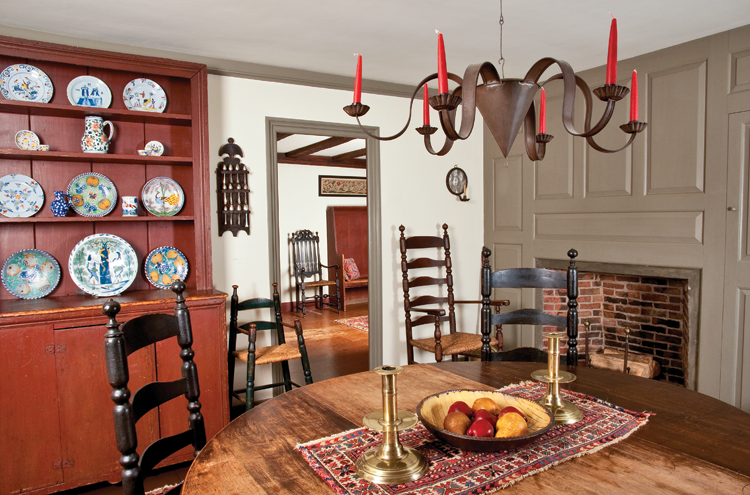
- English and Dutch ceramics sit on the eighteenth-century New Hampshire cupboard in the dining room. The slat-back chairs are part of a collection of ten side chairs and two armchairs, all from the same shop south of Boston, ca. 1725–1740. Visible through the doorway are a pierced-crested armchair in original black paint, ca. 1720, from the Massachusetts North Shore, and the hooded settle, a simple board piece in dry red paint, from New Hampshire, ca. 1780.
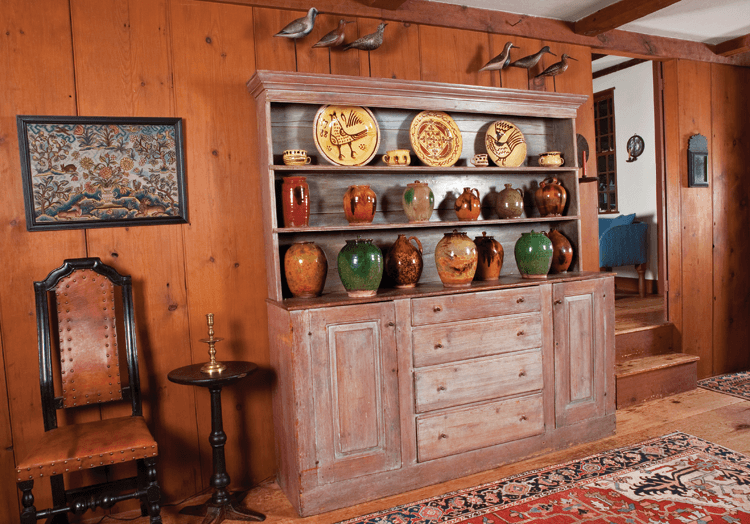
- The Massachusetts North Shore dresser shown was listed for sale in a small-town Florida newspaper. Cleaned down to its original paint, it retains its original knobs and cotter pin hinges, and was probably made either in coastal Massachusetts or in New Hampshire, ca. 1735–1750. It makes a fine display piece for part of the couple’s collection of New England redware and early English pottery. The boldly turned cross-base stand is from Rhode Island, ca. 1720–1735. The Boston leather chair, ca. 1720–1735, with arched and molded crest, retains its original black paint and full Spanish feet. Over the chair and stand is a beautifully stitched wool canvaswork by a daughter of the Wing family of Sandwich, Massachusetts, and “worked” in the late seventeenth or early eighteenth century. It relates to only one other known American piece with these motifs, which are largely taken from seventeenth-century English pattern books. The light-blue background projects the floral and animal designs complete with resting stag and lion.
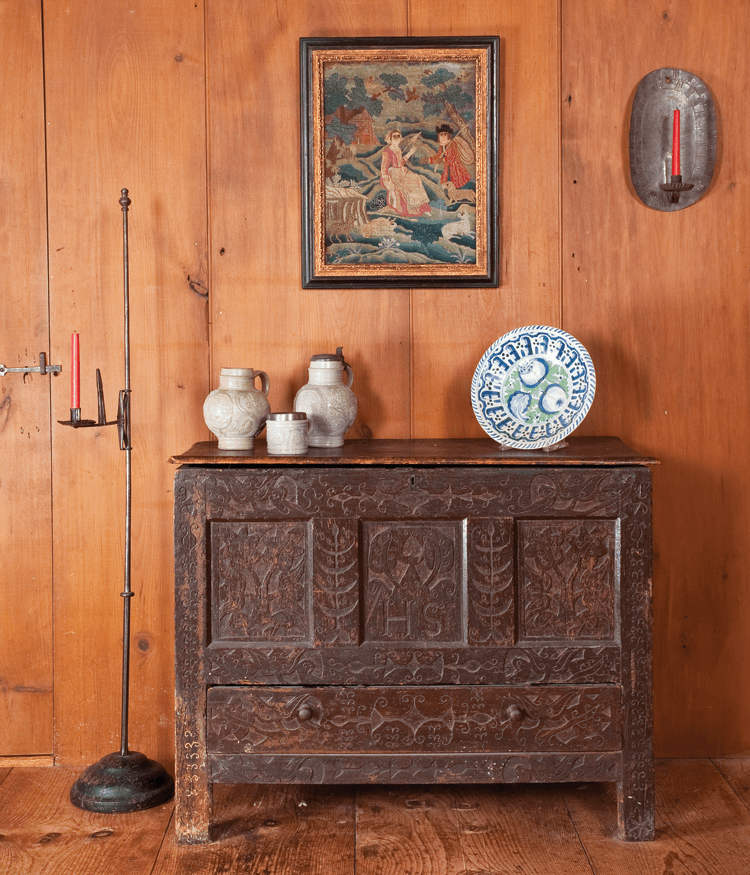
- The chest over drawer from the Hadley/Hatfield area of the Connecticut River Valley, ca. 1690–1715, retains its original deep red paint under an old, worn coat of varnish. It was found in an attic in Indiana in the 1980s, stuffed with quilts. The identity of the initials “HS” is not known. Over the choice pieces of European stoneware and charger hangs a rare canvaswork picture stitched ca. 1740 in the Boston area. A spinner and a shepherd sit in a landscape, a scene taken from a series of prints referred to as “The Fishing Lady,” engraved in France in the late seventeenth century and widely copied by young ladies in Boston.
Often collections showcase a few key pieces and use lesser objects to fill in the space. Such is not the case here. In fact, the couple’s home is so casual and comfortable that the significance of what the collection contains can easily be overlooked. The redware from the Massachusetts South Shore is exceptional, as is the German stoneware. Theirs is one of the best collections of New England schoolgirl needlework in the country. Assembled with the help and guidance of Stephen and Carol Huber, the couple became interested in the textiles after the wife made and hung curtains that she embroidered. Realizing the significance of needlework within the families of the young ladies who stitched these pictures at schools in the seventeenth and eighteenth centuries, and their emphasis on religion in daily life, the collectors have focused on early canvaswork, of which they have accumulated over a dozen, and samplers preceding the nineteenth century. Their careful selections include samplers from the school of Martha Pease Davis, Warren, Rhode Island, from, Mrs. Usher’s school, Bristol, Rhode Island; and from Sarah Stivour’s school in Salem, Massachusetts. They also own an early Adam and Eve sampler from Boston, and a New York sampler with layered format.
Furniture has been a main interest, and among the highlights of their collection are a spindle-turned Hinckley family cradle, a Boston upholstered armchair, a seventeenth-century tape loom, three carved document boxes—two from the Dennis/Searle shops—a seventeenth-century center table from Springfield, Massachusetts, the Bonney family “tuck-a-way “ table, a “Brewster” chair, several “Carver” chairs, a Tinkham chair, several important Boston leather chairs, a Boston couch or daybed, stretcher tables, a tulip and sunflower chest, a Hadley chest, a fabulous paint decorated Connecticut Valley chest of drawers and a clock with dial signed by Paul Rogers of Berwick, called “the earliest tall clock made in Maine”; it is one of three early tall clocks in the collection. These pieces and more are complemented by tribal rugs, candlesticks, and numerous small treasures. The depth and breadth of this collection cannot be captured in one article. Every object has been chosen for its rarity, form, and surface quality.
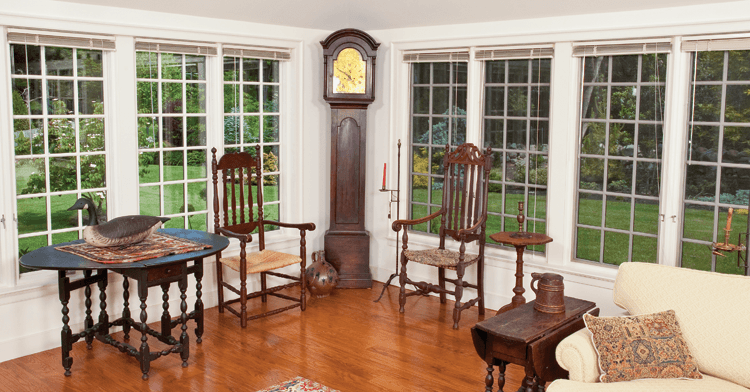
- Among the furniture in the “great room,” a relatively new wing added to the house, is a maple gateleg table is from eastern Massachusetts, ca. 1720–1730. A Joe Lincoln goose sits on the table. The banister-back armchair from the Waltham area of Massachusetts, ca. 1740, was one of the couple’s first acquisitions. The Queen Anne-style clock is signed by John Bailey II of Hanover, Massachusetts, ca. 1785. The engraved decoration on the dial is filled with colored wax—a rare feature. The pierced-crested banister-back armchair, with ”ram’s-horn” arms and boldly turned stretchers, retaining its original red paint, is from Boston, ca. 1720, and is exceptional. The octagonal-topped candlestand with telescoping post is from Rhode Island, ca. 1740–1760. The Massachusetts gateleg table beside the sofa, also with original surface, is only twenty-six inches long. The stoneware jug, dating to the sixteenth century and splashed with manganese, and the wrought iron eighteenth-century lighting device, with turned brass finial, reflect the quality of accessories throughout the collection.
Many of the objects have interesting or unusual histories. The Massachusetts North Shore dresser in the den, holding much of the redware, was discovered listed in the want ads in a small town newspaper in Florida. The ball-turned stretcher table in the front bedroom was also found in Florida. It had gone south in 1916 and remained in the same sunroom until spotted by a New England picker who moonlighted as a house painter. The Hadley chest was found full of quilts in an attic in Indiana. It had migrated by wagon from central Massachusetts in the late eighteenth century to Ohio, then to Indiana in the late nineteenth century. The wonderful spool-turned tape loom, on the other hand, hardly moved at all. It was found in Ipswich, in the attic of the longest continually owned working farm in New England. The Carver chair in the great hall of the pool house descended in the family of General Israel Putnam of Danvers, Massachusetts. The sunflower chest and painted Connecticut chest were long in storage in one of the country’s major museums, reportedly traded out in exchange for work performed in the 1950s. The ‘tuck-a-way’ table was acquired from the Bonney family, and family members stated that it had actually been used in the current owner’s house in the late eighteenth and early nineteenth centuries. The Hinckley cradle, arguably the rarest piece in the collection, descended in the husband’s family.
Putting together a collection of this quality and scope takes both focus and passion. Being able to assemble the pieces into a warm and comfortable home requires a sensitivity to the objects, as well as to time and place. It is that sensitivity that has created what you see here. As the husband says, “We feel that we are preserving part of our history for future generations. These things were part of everyday life for people, and it’s that connection to the past and the warmth and beauty of early surfaces that have always resonated most with us. If I walk by a piece in our collection and don’t notice it, I shouldn’t own it!”
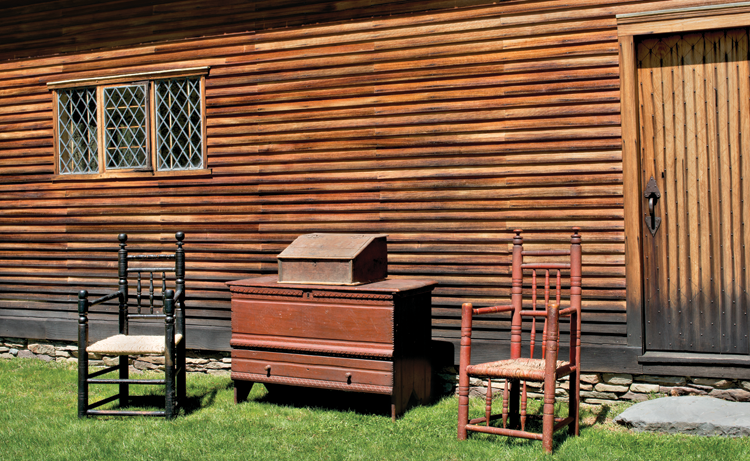
- This staged photo in front of the pool house depicts the visually “tactile” surface quality of the aging clapboards of the house and the painted surfaces of the furniture displayed within. The Carver chair, ca. 1670–1690, to the left, descended in the family of one of the first settlers of Danvers, Massachusetts. The chest with drawer is from Plymouth County, has saw-tooth carving on both the drawer and case, is punch decorated across the entire drawer front, and retains a rich, old salmon-color painted surface. This is one of five punch-decorated chests in the collection, one of which is the earliest known dated six-board chest with a scrolled skirt. The turned chair on the right, with a row of spindles below the seat and slots for a board seat, dates to 1660–1675, and is probably from the Boston area. The oak and pine desk box, made in eastern Massachusetts in the third quarter of the seventeenth century, is a remarkable survival and retains its original red and black paint and great cock’s-comb hinges. Descended in the Wetherbee family of Marlborough, Massachusetts, when found it was filled with Wetherbee family papers dating from the early eighteenth through the late nineteenth centuries.
—
The collectors would like to thank Brian Cullity and Stephen and Carol Huber for their help in forming the collection. They would particularly like to thank Peter Eaton.“We knew that we needed the guidance of someone who was knowledgeable and specialized in the things that we cared about. We feel fortunate to have developed a long-term relationship of trust with Peter. He has helped us develop our taste, and an understanding and appreciation of style, surface, and beauty.”
With appreciation to Stephen and Carol Huber for their contribution to the text.
This article was originally published in the Summer 2013 issue of Antiques & Fine Art magazine, a digitized version of which is at afamag.com. AFA is affiliated with Incollect.com.
Peter Eaton is an antiques dealer specializing in seventeenth- and eighteenth-century furniture and decorative arts. He lives with his wife, folk art dealer Joan Brownstein, in Newbury, Massachusetts, where their shop is also located.







